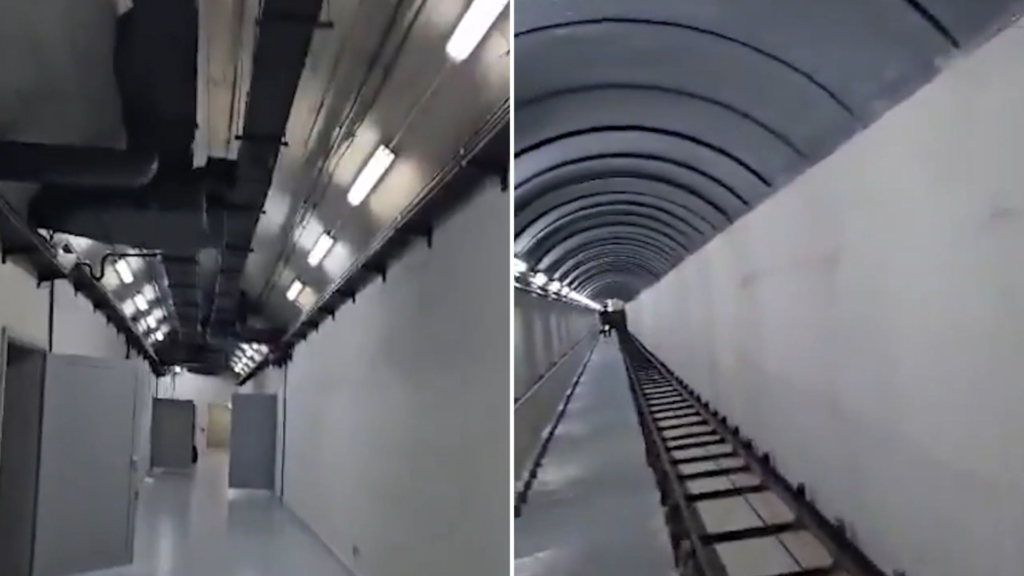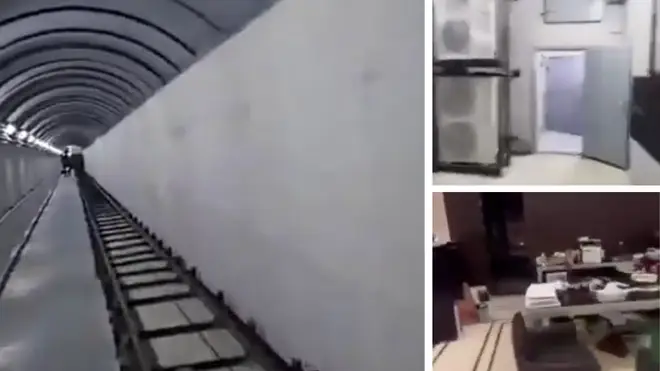The Assad regime’s reign in Syria, marked by decades of unyielding control, has come to an abrupt end amid dramatic revelations of hidden infrastructure beneath the family’s palatial residences.
Among these is a sprawling network of tunnels and bunkers reportedly used for safeguarding the regime’s wealth and resources during Syria’s protracted civil war. This discovery, coupled with the rapid collapse of Bashar al-Assad’s government, has sent shockwaves across the region.
The Discovery of a Hidden Tunnel Network
A video has emerged on social media, purportedly showcasing an extensive tunnel network beneath the mansion of Maher al-Assad, brother of Bashar al-Assad and leader of the Syrian army’s elite Fourth Division.
The footage reveals a labyrinth of wide, reinforced tunnels large enough to accommodate trucks loaded with goods like gold and Captagon, a notorious drug linked to funding conflicts in the region.
The video, apparently filmed by an opposition fighter, depicts doors leading to reinforced chambers, staircases descending into the earth, and long corridors with curved ceilings.
Reports suggest the tunnels were outfitted with ventilation systems, living quarters, and heavy security measures, signaling their use as more than just emergency escape routes. They were likely part of a contingency plan for the Assad regime to maintain control, move resources, or escape in times of crisis.
Massive tunnel complex beneath Maher Assad's mansion, wide enough for trucks carrying Captagon and gold to drive through. pic.twitter.com/q7lmlLOfqi
— Akıncı (@YavuzSelim23_1) December 8, 2024
This discovery sheds light on the lengths to which the Assad family went to secure their rule. The tunnels not only stored wealth but also potentially served as conduits for illicit trade, fueling speculation about the regime’s clandestine operations during the civil war.
The Collapse of Assad’s Rule
The unearthing of the bunker coincides with the stunningly swift fall of Bashar al-Assad’s regime. Rebel forces, led by the Hayat Tahrir al-Sham (HTS) group, entered Damascus following a lightning offensive that began in late November.
The opposition’s advance saw key cities like Aleppo, Homs, and Hama fall with little resistance, culminating in the capture of the Syrian capital.
Read : Watch Thousands of Cars Line Up to Enter Syria from Lebanon After Assad Government Falls
Crowds in Damascus flooded the streets to celebrate the end of the Assad family’s five-decade rule. Jubilant chants, car horns, and prayers echoed through the city as government soldiers abandoned their posts and looters stormed the Ministry of Defence headquarters. Opposition fighters entered the presidential palace, marking a symbolic end to an era of authoritarianism.
In a rare broadcast, Syrian state television aired a statement from the rebel group Operations Room to Conquer Damascus, declaring the overthrow of Bashar al-Assad and the liberation of detainees.
Bashar al-Assad, who had ruled Syria for nearly 14 years, reportedly fled the country for an undisclosed location, leaving behind a power vacuum that opposition leaders are now working to fill.

The opposition’s success has been attributed to strategic alliances and the waning morale of the Syrian army. HTS, initially an al-Qaeda affiliate, has rebranded itself in recent years, distancing from extremist roots to gain broader acceptance.
This transformation has allowed the group to lead the charge in unifying opposition factions, achieving a level of success unseen since the early days of the civil war.
The Way Forward for Syria
As the dust settles, Syria faces the monumental task of rebuilding its fractured state. Rebel leaders have called for calm and unity, urging citizens to preserve state institutions for the future of a “free Syrian state.”
Meanwhile, the Alawite community, long associated with the Assad regime, has appealed for dialogue and peace to avoid further fragmentation.
The transitional government faces numerous challenges, including securing international recognition, addressing humanitarian needs, and ensuring the safety of civilians in formerly contested areas.
The discovery of the Assad family bunker adds another layer of complexity, highlighting the need for transparency and accountability in handling the regime’s hidden assets.

The international community has reacted cautiously, with the United Nations calling for urgent talks to facilitate an orderly political transition. Neighboring Israel has bolstered its military presence along the Golan Heights, reflecting concerns over potential spillover effects from Syria’s volatile situation.
For the Syrian people, the fall of the Assad regime represents both a moment of liberation and a crossroads. While the collapse of a dictatorship brings hope for democracy and justice, the path to stability remains fraught with uncertainties.
As the nation navigates this new chapter, the lessons of the past and the resilience of its people will undoubtedly shape Syria’s future.
The discovery of a secret tunnel and bunker beneath the Assad family residence serves as a stark reminder of the shadowy methods employed by authoritarian regimes to cling to power. This revelation, coupled with the dramatic collapse of Bashar al-Assad’s rule, marks a pivotal moment in Syria’s history.
As the nation embarks on the difficult journey of rebuilding, the uncovering of these hidden infrastructures underscores the importance of transparency and accountability in creating a future built on trust and unity.
let’s enjoy few years on earth with peace and happiness….✍🏼🙏

